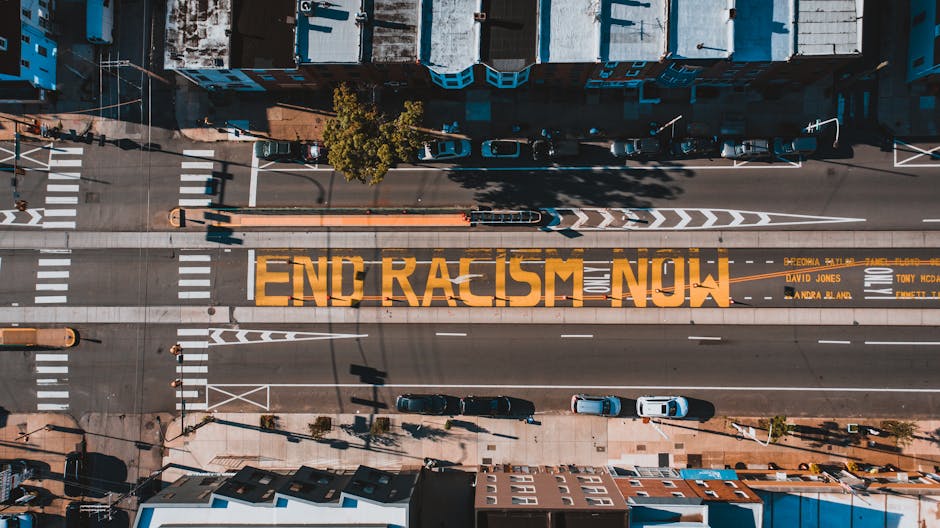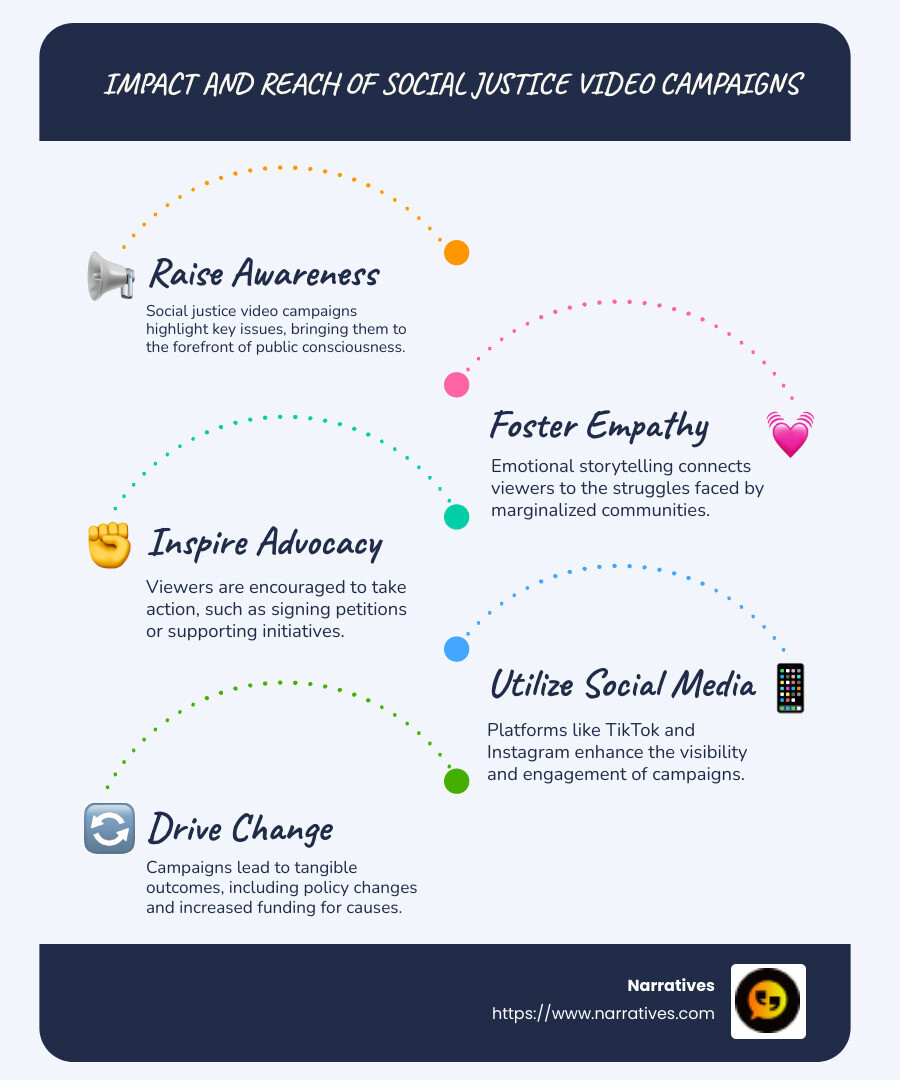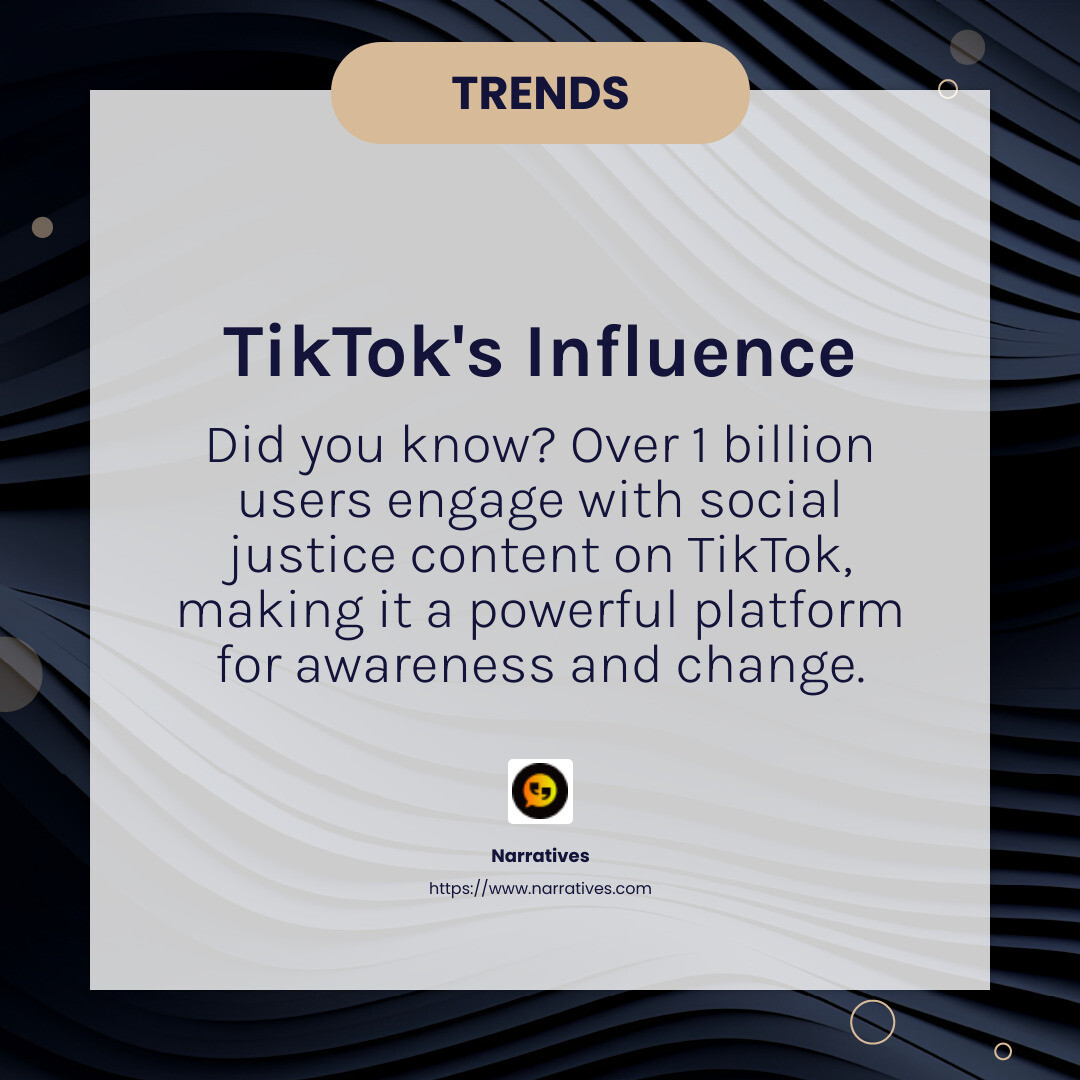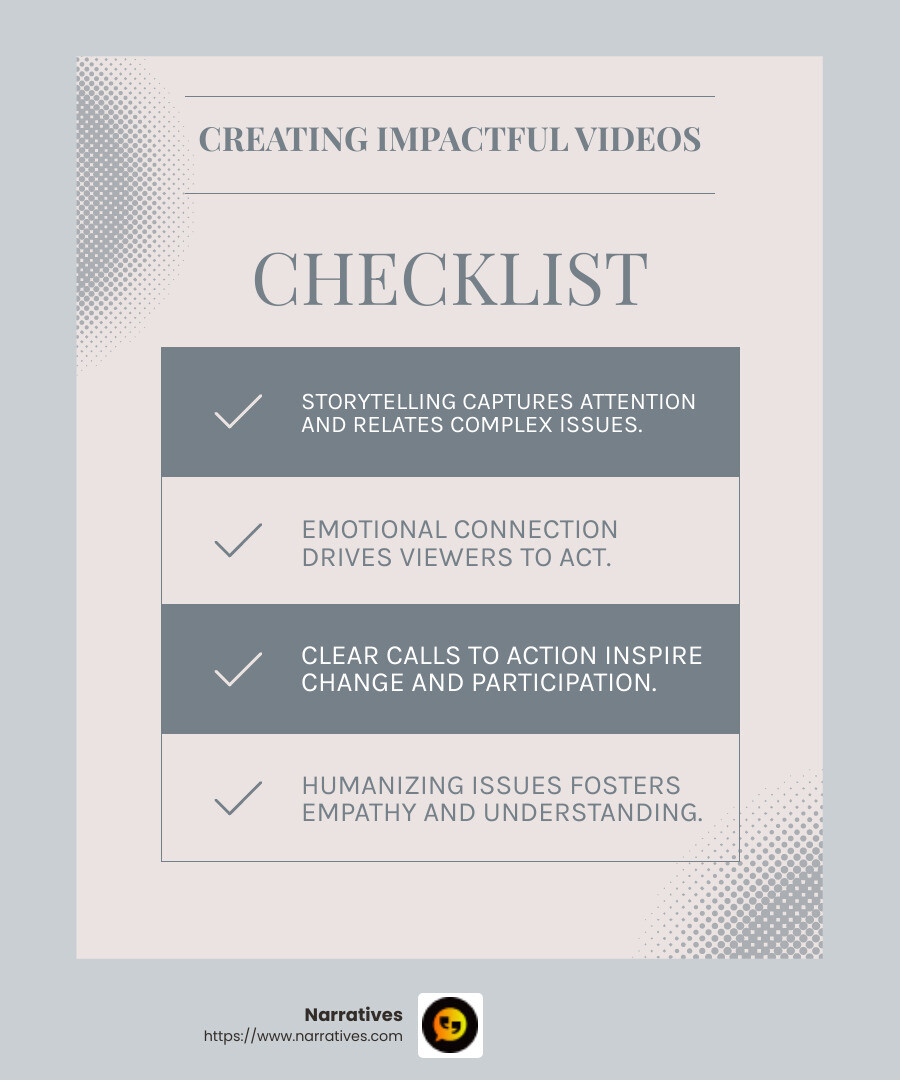Video Voices: Powerful Social Justice Campaigns

Social justice video campaigns have become a vital tool in driving awareness and change on significant issues. These campaigns use powerful storytelling to connect with audiences emotionally, making complex social issues accessible and inspiring action.
- Purpose: To highlight social justice issues and drive change.
- Methods: Engaging storytelling, visual imagery, and emotional narratives.
- Channels: Social media platforms like TikTok and immersive technologies like virtual reality.
- Impact: Raises awareness, fosters empathy, and encourages advocacy.
When people are increasingly consuming content online, video campaigns have proven to be uniquely effective in shaping public dialogue around justice and equality. Platforms like TikTok have amplified these campaigns, making them accessible and engaging, especially for a younger audience.
By using creativity and emotional storytelling, these campaigns not only inform but also unite communities around a common cause. They transform viewers from passive observers into active participants, helping foster a more inclusive and equitable society.

The Power of Social Justice Video Campaigns
Social justice video campaigns wield immense power in today's digital age. They leverage video content to create a profound social impact by telling compelling stories that resonate with viewers. But what makes these campaigns so effective?
Storytelling: The Heartbeat of Impact
At the core of any successful social justice video is storytelling. It's the emotional connection that draws viewers in and compels them to act. By sharing authentic stories of individuals affected by various issues, these videos humanize complex topics, making them relatable and urgent. For instance, campaigns that highlight personal narratives of marginalized communities can shine a light on their struggles and triumphs, fostering empathy and understanding.
Driving Change Through Emotional Engagement
The ultimate goal of these campaigns is to inspire action. Whether it's encouraging donations, volunteering, or simply spreading the word, social justice video campaigns make it easy for audiences to engage and become part of the solution. A well-crafted video can turn a passive viewer into an advocate for change, as seen in the widespread support for movements like Black Lives Matter, which gained significant traction through platforms like TikTok.

Amplifying Voices and Raising Awareness
One of the most powerful aspects of these campaigns is their ability to amplify voices that might otherwise go unheard. By giving a platform to marginalized communities, videos can bring critical issues to the forefront, ensuring that these voices are not only heard but also listened to. This was evident in the way TikTok became a hub for Gen Z to learn about and engage with social justice issues, with 76% of the demographic believing that brands should help make a difference in the world.
The Role of Platforms
Different platforms offer unique strengths for amplifying these messages. TikTok is especially effective for reaching younger audiences with its trend-driven, viral content. Meanwhile, LinkedIn provides a more professional setting for advocacy on issues like workplace diversity and corporate responsibility. Choosing the right platform is crucial to ensure the message not only reaches but also resonates with the intended audience.
By combining storytelling with the reach of digital platforms, social justice video campaigns have the power to educate, mobilize, and inspire. They are not just tools for spreading awareness but are catalysts for real-world change.
5 Notable Social Justice Video Campaigns
Social justice video campaigns have the power to bring about real change, and here are five notable examples that highlight their impact across different narratives and initiatives.
Narratives: Dove's Real Beauty Sketches
The "Real Beauty Sketches" campaign by Dove is a perfect example of how narratives can reshape societal perceptions. By illustrating the gap between how women see themselves and how others see them, Dove created a powerful emotional experience. This campaign went viral, sparking a global conversation about beauty ideals and self-acceptance. It wasn't just an ad; it was a movement that encouraged women to accept their true selves.
Global Initiatives: Nike's Equality
Nike's "Equality" campaign, launched in 2017, took on the global issue of racial inequality. Featuring athletes like LeBron James and Serena Williams, this campaign used stark visuals and strong messaging to promote equality in sports and society. The campaign resonated worldwide, backed by public donations and community programs. It wasn't just about selling shoes; it was about making a statement that echoed across the globe.
Community Voices: Always' #LikeAGirl
The #LikeAGirl campaign by Always transformed a common insult into a message of empowerment. By engaging participants to perform tasks "like a girl," the campaign highlighted how confidence drops during puberty for young girls. This initiative changed the narrative, turning a derogatory phrase into a badge of honor. It positively influenced the self-image of girls and women, proving the power of community voices in driving social change.
Change Makers: Heineken's Worlds Apart
Heineken's "Worlds Apart" campaign tackled societal polarization by bringing people with opposing views together over a beer. The campaign emphasized that there's more that unites us than divides us. This social experiment was praised for promoting open dialogue and understanding, showing how change makers can bridge divides and foster unity through simple yet powerful interactions.
Impact Stories: Patagonia's Don't Buy This Jacket
Patagonia's bold "Don't Buy This Jacket" campaign during Black Friday highlighted the environmental impact of consumerism. By urging consumers not to buy their products, Patagonia focused on sustainability and responsible purchasing. This campaign sparked widespread discussion about environmental responsibility and showcased how impact stories can lead to meaningful conversations and actions.
These campaigns are shining examples of how brands can use their influence to promote social justice. By engaging with deep-seated issues through compelling narratives, community voices, and impactful stories, these video campaigns resonate deeply with audiences and contribute to societal progress.
Creating Impactful Social Justice Videos
Creating impactful social justice videos requires a blend of storytelling, emotional connection, and inspiring action. Each element plays a crucial role in engaging audiences and driving change.
Storytelling: The Heart of the Campaign
Storytelling is the cornerstone of any successful social justice video campaign. It’s about weaving narratives that capture the audience's attention and make complex issues relatable. For instance, Dove's "Real Beauty Sketches" used storytelling to challenge beauty standards and empower women globally. It wasn't just about selling a product; it was about starting a conversation that resonated with millions.
A compelling story often involves real people and real experiences. By focusing on personal stories, these videos humanize social issues, making them more relatable. This approach not only educates but also fosters empathy among viewers.
Emotional Connection: Engaging the Audience
An emotional connection is vital for any social justice video campaign. When people feel something, they're more likely to act. Nike's "Equality" campaign is a prime example. By featuring prominent athletes like LeBron James and Serena Williams, the campaign connected emotionally with audiences worldwide. It wasn't just about promoting equality in sports; it was about inspiring viewers to support racial equality in all aspects of life.
Emotional storytelling can take many forms—joy, sadness, anger, or hope. The key is to evoke genuine emotions that align with the campaign's message. This emotional engagement encourages viewers to reflect on their beliefs and consider taking action.
Inspiring Action: Moving from Awareness to Change
The ultimate goal of a social justice video is to inspire action. Whether it's signing a petition, donating to a cause, or simply sharing the video, the call to action should be clear and compelling. For example, Patagonia's "Don't Buy This Jacket" campaign urged consumers to think about environmental sustainability, sparking discussions about responsible consumption.
A strong call to action is specific and actionable. Instead of vague prompts like "support the cause," effective campaigns give viewers clear steps to follow. This approach not only informs but also empowers audiences to become active participants in the movement.

Creating impactful social justice videos involves a delicate balance of storytelling, emotional connection, and inspiring action. By focusing on these elements, campaigns can transform passive viewers into engaged advocates, driving meaningful change in society.
Trends in Social Justice Video Campaigns
Social justice video campaigns are evolving rapidly, adapting to new technologies and audience preferences. Let's explore some of the latest trends shaping these campaigns.
Virtual Reality: Immersive Experiences
Virtual reality (VR) is changing how we experience social justice issues. By immersing viewers in a virtual world, VR can evoke empathy and understanding in a way traditional videos can't. Imagine putting on a VR headset and stepping into the shoes of a refugee or protester—it's a powerful way to experience their struggles firsthand.
For example, VR experiences have been used to highlight the realities of climate change and the refugee crisis, allowing viewers to "walk" through flooded homes or crowded camps. This immersive approach makes complex issues more tangible and urgent, prompting viewers to act.
Influencer Collaborations: Reaching Wider Audiences
Influencer collaborations are becoming a cornerstone of social justice video campaigns. By partnering with influencers, campaigns can reach broader audiences and tap into established communities of followers. Influencers bring credibility and relatability, making the campaign's message more impactful.
TikTok, for instance, has become a hub for social justice content. Influencers on the platform often create short, engaging videos that spread awareness quickly. Brands like Chipotle and JanSport have successfully used TikTok to engage younger audiences with social justice messages, from LGBTQ+ rights to mental health awareness.
Data-Driven Personalization: Tailoring Messages
Data-driven personalization is enhancing the effectiveness of social justice video campaigns. By analyzing audience data, campaigns can tailor messages to resonate with specific demographics or individual viewers. This targeted approach ensures that the message is relevant and impactful.
For instance, platforms like Facebook and Instagram allow for highly targeted advertising, enabling campaigns to reach users based on their interests, behaviors, and demographics. Personalization not only increases engagement but also fosters a deeper connection with the audience, encouraging them to take action.
In summary, social justice video campaigns are leveraging cutting-edge technologies and strategies to maximize their impact. From virtual reality to influencer collaborations and data-driven personalization, these trends are helping campaigns reach and resonate with audiences like never before.
Frequently Asked Questions about Social Justice Video Campaigns
What are social justice video campaigns?
Social justice video campaigns are powerful tools that use video content to highlight and address societal issues such as equality, human rights, and environmental justice. These campaigns aim to raise awareness, educate viewers, and inspire action. By telling compelling stories, they connect emotionally with audiences, making complex issues relatable and urgent.
For instance, platforms like YouTube offer a space for these narratives, allowing creators to reach a broad audience with impactful messages. Videos can range from short clips that go viral on social media to in-depth documentaries that explore issues in detail.
How do social justice video campaigns inspire change?
Social justice video campaigns inspire change by tapping into the power of storytelling and emotional connection. They often feature real-life stories that humanize the issues, making them more relatable. For example, by sharing personal experiences of those affected by a cause, these videos can evoke empathy and compassion.
The ultimate goal is to motivate viewers to take action. This could mean signing a petition, making a donation, or simply sharing the video to spread the message further. Campaigns often include clear calls to action, such as "Join 100,000 others who demand change," which leverage social proof to encourage participation.
Moreover, these videos amplify marginalized voices, ensuring they are heard and their concerns are addressed. By educating the public and mobilizing communities, social justice video campaigns turn passive viewers into active advocates for change.
What platforms are best for social justice video campaigns?
Choosing the right platform is crucial for the success of social justice video campaigns. Each platform offers unique advantages:
Facebook & Instagram: These platforms have billions of users and offer robust targeting options. They are ideal for engaging storytelling through videos and interactive posts, making them perfect for reaching diverse audiences.
YouTube: As the second-largest search engine, YouTube is excellent for detailed storytelling. It allows for deep dives into issues with documentary-style videos or educational content, building a strong emotional connection with viewers.
TikTok: Known for its short, engaging videos, TikTok is particularly effective for reaching Gen Z. It has become a hub for social justice content, with influencers using the platform to spread awareness quickly and effectively.
X (formerly Twitter): This platform excels in real-time discussions and trending topics. It's a great choice for campaigns that aim to tap into current events or ignite immediate action.
In summary, each platform offers unique opportunities to engage and mobilize audiences, making them invaluable tools for social justice video campaigns.
Conclusion
At Narratives, we believe in the transformative power of digital storytelling to drive social change. Our mission is to lift the voices of non-profits and purpose-driven organizations through compelling video content that resonates with audiences and inspires action.
By focusing on social justice video campaigns, we help organizations share their impact stories in a way that builds trust and increases visibility. These campaigns are more than just videos; they are a means to amplify underrepresented voices and bring attention to critical issues.
Through our partnerships, we aim to create high-quality, emotionally engaging content that not only informs but also mobilizes communities to act. Whether it's addressing racial equality, environmental justice, or human rights, our videos are crafted to connect with viewers on a personal level, making complex topics accessible and urgent.
As the go-to digital storytelling partner for non-profits, we are committed to using our expertise to support those who are making a difference. By using the potential of video, we strive to turn passive viewers into active participants in the movement for social justice.
When stories have the power to spark change, Narratives is dedicated to ensuring that every story told is one step closer to a more just and equitable society.


